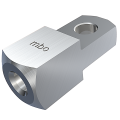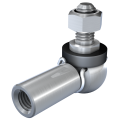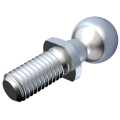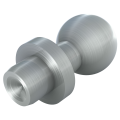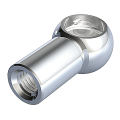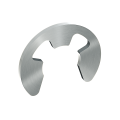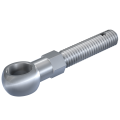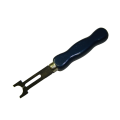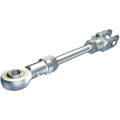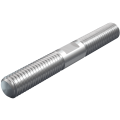Rod ends hydraulic DIN 24555 / ISO 8133 small version
can be regreased, with small bearing, able for standard hydraulic-cylinders pressure 160 bar acc. to ISO 6020/2Fast-track this part (max. 400 units) through our production facility. Shorten the delivery time by 1-2 working days. We are currently exclusively testing this delivery service for Germany.
incl. VAT
plus shipping costs
To cancel your filter settings again, click on the "Clear" button below the table.
You can display product details, including the eShop function and 3D model , by clicking in the row corresponding to the required article.
1. Product description
Rod ends hydraulic according to DIN 24555 / ISO 8133 in the small version are mechanical linking elements that allow point force transmission between movable components while permitting swivel or rotational movements. They act as essential connection points in hydraulic systems, enabling articulated movement and load transfer across various axes. This is achieved through their special design, which allows adjustments to angular deviations during operation, ensuring efficiency and reliability even under high loads or adverse conditions. The main differences between a rod end hydraulic DIN 24338 and a DIN 24555 lie in the specified dimensions, which are precisely tailored to different application requirements.
2. Product details
Size: 12 M10FG - 100 M64FG
Material group: Steel
Surface: Bright
Thread version: Fine-pitch thread right
3. Application Areas & Compatibility
Rod ends hydraulic according to DIN 24555 / ISO 8133 in the small version are used in various industries and mechanical engineering, including:
Machinery and plant engineering: In this area, rod ends hydraulic enable precise control of movements and loads. They are indispensable for the functionality of hydraulic presses, CNC machines, and other automated manufacturing systems.
Construction machinery and vehicles: Hydraulic cylinders are an essential component of numerous construction machines such as excavators, bulldozers, cranes, and other heavy vehicles. They ensure precise movements and the handling of large loads, which is indispensable in the construction industry. Rod ends hydraulic according to DIN 24555 / ISO 8133 are specifically designed to withstand these high loads and to provide a permanently secure connection between the hydraulic cylinders and the mechanical structure of the machines.
Agricultural vehicles and machinery: In agricultural technology, rod ends hydraulic are used to ensure the smooth operation of tractors, combine harvesters, and other agricultural machinery. The robustness and durability of these rod ends guarantee reliability even under demanding working conditions.
Compatibility with hydraulic cylinders and systems: These rod ends are specifically designed and standardized according to DIN 24555 and ISO 8133 to serve as connecting parts for hydraulic cylinders and systems. The standardization facilitates integration into existing systems and guarantees compatibility with internationally recognized standards.
4. Advantages and Benefits
Precise movement control: Thanks to their ability to accommodate angular movements as well as axial and radial loads, rod ends hydraulic provides precise control of movements. This is crucial in systems where accurate positioning is essential.
Compensation of misalignments: Rod ends hydraulic offer the key advantage of compensating for misalignments and movement tolerances between connected components. This minimizes mechanical stresses and deformations, contributing to the extended lifespan of components.
Durability in demanding environments: Made of high-quality materials such as steel, these rod ends withstand corrosive environments, high loads, and wear even under challenging operating conditions, making them a reliable choice for long-term applications.
Easy installation and maintenance: Standardization according to DIN and ISO standards simplifies the selection and replacement of rod ends by ensuring compatibility with existing systems and components. Additionally, rod ends hydraulic DIN 24555 / ISO 8133 small version allows for easy installation and maintenance due to their thoughtful design.
Various customization options: Availability in different sizes, shapes, and with varying technical specifications allows for meeting the specific needs of diverse applications. This enables designers to choose the rod ends that are optimally suited to their specific requirements.
Increased system reliability: Rod ends hydraulic enhance the reliability of the entire system by reducing mechanical stresses and optimizing movement control. Their robustness and capability to operate reliably in demanding environments reduce the need for frequent repairs and replacements.
In summary, rod ends hydraulic DIN 24555 / ISO 8133 small version significantly improve the performance and reliability of hydraulic and mechanical systems. They offer an effective solution for movement control and load transfer, optimizing the efficiency and durability of machines and systems.
5. Assembly and Installation
Preparation and planning: Before starting the assembly, it is crucial to thoroughly analyze the specific requirements of the application. This includes examining the load conditions, directions of movement, and environmental conditions. Equally important is the selection of the appropriate rod end type and the corresponding size.
Examination of components: Before installation, the rod ends hydraulic and the adjacent parts should be inspected for damage, corrosion, or manufacturing defects. This ensures that only flawless parts are used, guaranteeing the safety and functionality of the entire system.
Correct alignment: Precise placement and alignment of the rod end hydraulic are crucial to avoid misloads and premature wear. Particularly, the alignment of the axes should be thoroughly checked to ensure axial and radial loads can be properly absorbed.
Fasteners: Using the appropriate fasteners and tightening them with the correct torque is essential for a secure connection. This ensures that there is no loosening or displacement during operation.
Lubrication: Proper lubrication of the rod end is crucial for smooth operation and wear reduction. The lubricant should be carefully matched to the operating conditions and material compatibility.
Post-assembly inspection: After installation, it is important to perform an inspection to ensure that all components are correctly assembled and that movements can proceed as intended. This may also require adjustment of alignment or torque.
6. Safety instructions & Standards
Product-specific standards: Compliance with product-specific standards, such as DIN 24555 or ISO 8133 for rod ends hydraulic, is essential. These standards set requirements for materials, dimensions, and performance characteristics to ensure that the products operate reliably under the intended operating conditions.
Load limits: Awareness and adherence to the established load limits are of utmost importance. Overloading can lead to rapid wear, failure of the rod end, and, in the worst case, accidents.
Safety inspections: It is necessary to regularly inspect mechanical connections for safety to identify potential damage or wear early and to take appropriate actions.
Environmental conditions: Another crucial aspect is consideration of the environmental conditions under which the rod ends hydraulic are used. Extreme temperatures, humidity, and aggressive chemicals can affect the materials and may require special measures. By adhering to these safety instructions and standards, risks can be reduced, the safety of users and others can be increased, and the proper functioning of the systems in which the hydraulic rod end are used can be ensured.



